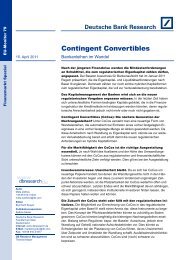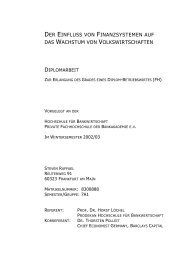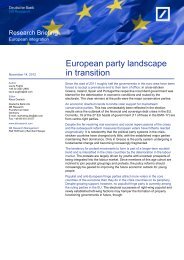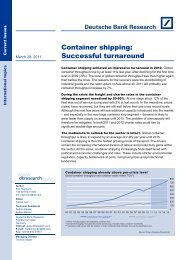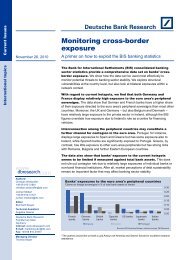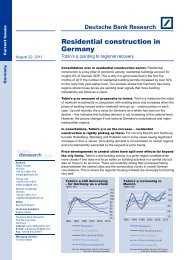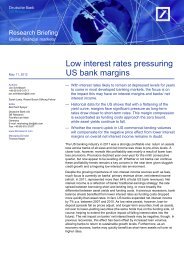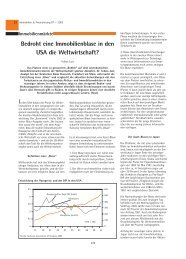Dynamic diversity opens up opportunities - Deutsche Bank Research
Dynamic diversity opens up opportunities - Deutsche Bank Research
Dynamic diversity opens up opportunities - Deutsche Bank Research
You also want an ePaper? Increase the reach of your titles
YUMPU automatically turns print PDFs into web optimized ePapers that Google loves.
High equity ratio serves as cushion in<br />
crisis<br />
Innovations: also important for SMEs<br />
EU-27: SMEs generating<br />
income from innovations<br />
Headcount<br />
250+<br />
50 to 249<br />
10 to 49<br />
1 to 9<br />
%<br />
0 20 40 60 80<br />
Source: Eurobarometer 2006<br />
25<br />
Current Issues<br />
Changes in financial market structures including integrated global<br />
markets and intensified competitive pressures have resulted in<br />
German SMEs now also starting to boost their equity. Most of the<br />
companies surveyed said back in 2005 that equity financing would<br />
gain importance for them going forward. A healthy capital adequacy<br />
policy is urgently required for new start<strong>up</strong>s, innovative companies<br />
and crisis sectors in particular so they can be better prepared for<br />
changes in financing conditions. In light of the current financial and<br />
economic crisis the equity base and the diversification of financing<br />
have become more important for SMEs to enable them to ride out<br />
the downturn and rapidly regain their footing for the coming<br />
<strong>up</strong>swing.<br />
5. Where will the journey lead? Future determinants<br />
for SMEs<br />
Technological progress is the ultimate engine of economic growth.<br />
Economist Joseph Schumpeter said that the distinguishing feature<br />
of entrepreneurs is their desire to continually improve their economic<br />
position through innovations. Entrepreneurial spirit creates<br />
innovations and hence economic growth and structural change.<br />
Whether innovations become established in the market depends<br />
strongly on how companies go about it, but this also depends on the<br />
degree of cultural acceptance and demand for innovative products,<br />
without which fewer innovations would be created. Both the<br />
innovation climate in the respective countries as well as the size of<br />
the company and its sector affiliation determine the intensity of<br />
innovation. In the transport and construction sectors, innovations are<br />
less probable or necessary a factor for a firm to be able to hold its<br />
own than they are in distributive trade or the manufacturing sector,<br />
which thrive on new products. 30<br />
5.1 Innovation – economic growth driven by progress<br />
The EU’s Lisbon Strategy is an attempt to use a variety of political<br />
measures to boost productivity and the pace of innovation in order<br />
to match the economic performance of Japan and the US. The<br />
target set by the EU in 2000 to increase R&D spending to 3% of<br />
GDP (from 1.9%) by the year 2010 was retained when the Lisbon<br />
Strategy was revised. Moreover, the aim was for the share of the<br />
private sector in R&D investment to rise.<br />
In the EU, about three out of every ten firms have new products in<br />
their portfolio or are generating income from them. There are more<br />
of these SMEs generating income from innovations in the new<br />
member states than in the old ones. In a nutshell: the bigger a firm,<br />
the more likely it is to be innovative. While 62% of all micro firms<br />
generate income from new or improved products, the figure for large<br />
companies is over 75%. Across all size categories there is only a<br />
small difference in the share of revenues generated through<br />
company innovations (roughly 12%), while the share of innovative<br />
firms itself grows as firms increase in size. This results in smaller,<br />
innovative firms generating a comparatively large share of their<br />
revenues from innovations. 31<br />
The chief obstacles to innovations in the EU are cited as being<br />
financing problems, a scarcity of skilled labour, a lack of demand<br />
30 On the other hand, there is also an interpretation problem in distributive trade,<br />
since retailers who market innovative products automatically generate turnover<br />
through innovative products without being innovative themselves.<br />
31 Flash Eurobarometer Survey 2007.<br />
18 April 15, 2009



